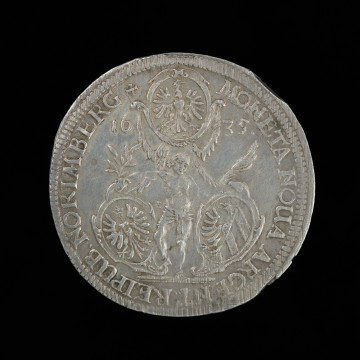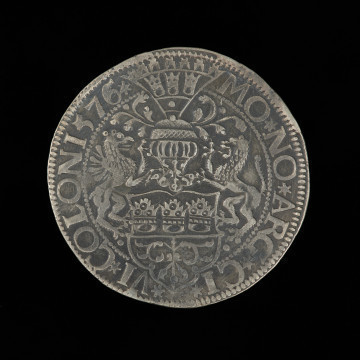
Thaler of the Reich
1624
National Museum in Szczecin
Part of the collection: German coins
Among the most characteristic thalers of Hamburg are those with the coat of arms of the city – a three-tower gate – on the reverse. Hamburg began minting such coins in the mid-16th century, but the most famous issues are from 1619–1646, the period of the Thirty Years’ War. These highly impressive coins bear the designation 32 on the royal apple, placed on the breast of the imperial eagle. This is a reference to the denomination of a coin equal to 32 silver shillings. The denomination of a thaler was usually expressed in pennies. The indication 24 is relatively frequent, but generally issuers did not place the denomination on their coins, which may have been the result of disputes lasting since the 16th century, concerning the silver content in the thaler, and thus the value of the coin itself. At the time of the spread of the thaler on the German money market, there was a divergence on this question. States without their own sources of bullion postulated the minting of coins of lower value. At first the emperor granted the request, but this caused the value of the gold and silver guilder, as the thaler was originally called, to diverge. Ultimately, Emperor Maximilian (1527–1576) set the value of the thaler at 68 kreuzers, corresponding to the 24 pennies already mentioned. However, this exchange rate was not respected in the south-eastern areas of Germany, where a conversion rate of 60 kreuzer was used. Thus, the lack of markings may be an attempt to avoid an unambiguous declaration of the value of the coin, whose denomination was determined only by its appearance and size. Like all bullion money, the thaler also lost value over time, either through a decrease in the amount of silver in the coin or a decrease in its weight. The decline in the value of the bullion itself was also not insignificant. Although there was no shortage of desire and action to restore its former role and splendour, the minting of thalers in Germany was finally ended in 1871. With the rise of the Second Reich under the aegis of Prussia came the era of a new currency, the mark.
Mieszko Pawłowski
Other names
Reichstaler
Author / creator
Dimensions
cały obiekt: diameter: 41.7 mm
Object type
coin, money
Technique
minting
Material
silver
Creation time / dating
Creation / finding place
Owner
National Museum in Szczecin
Identification number
Location / status

1624
National Museum in Szczecin

1623
National Museum in Szczecin

1576
National Museum in Szczecin
DISCOVER this TOPIC
Castle Museum in Łańcut
DISCOVER this PATH
Educational path